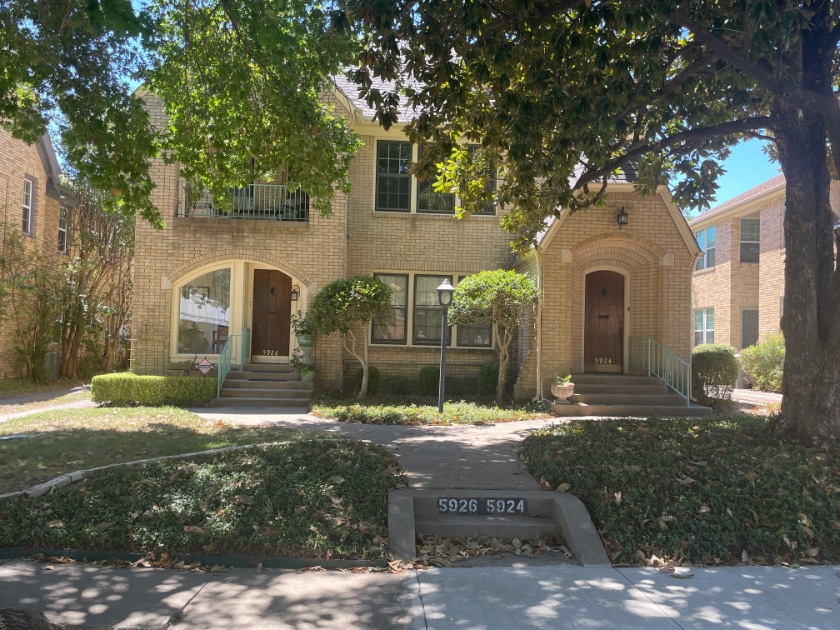
When I moved to Dallas after college, I rented a duplex in East Dallas. Everyone my age lived in either a duplex or an apartment in The Village. There were not a lot of options.
For me, a duplex meant the best of both worlds. It offered the right amount of privacy and, for two young single women, the security of a neighbor downstairs. My first duplex was at 6132 Llano, right across from Tietze Park. The landlady lived downstairs, so if something broke, it was immediately fixed. Oddly enough, it is one of the few remaining on that street today.
After several years we moved to 5924 Goodwin, down the street from what is now Geneva Heights Elementary School. It’s also still standing.


In our second duplex, the landlady’s mother lived downstairs. In both duplex situations, we knew our neighbors, felt like a real part of the neighborhood, and frankly had a blast in both places, throwing legendary parties — with permission, of course. We did not have to mow the lawn or deal with maintenance, and the rent was reasonable.
I wondered what was happening with those great old duplexes, how they came about in the first place, and if they might be a solution to some of our density problems today.

Edison/La Vista Court And The Historic Duplex
One of the best examples of duplex living is the Edison/La Vista Historic District. I’m sure most of us have never heard of it. That’s probably one reason it has remained intact. It’s a lovely tree-lined block of 15 English Tudor Revival two-story brick and stone duplexes built in 1929 as rental properties by Parks Development Company. The landmark form has Frank J. Woerner listed as the probable architect.


Originally named Edison Court, the development was unusual as it deviated from the normal setback of 25-30 feet. These duplexes were set back at a uniform 15 feet from the sidewalk, which makes this block seem more like a brownstone block in Boston or New York. It was renamed La Vista Court in 1947. Sometime in the 1960s, the original gates were removed from the Matilda Street end of the block, and the two-way street became one-way.
Fortunately, the owners of these beautiful historic duplexes got together and applied for Dallas Landmark Designation, which was issued in 1989.

The quality of the urban design, architectural style, and historic integrity gives the distinct uniqueness, cohesiveness, and integrity that make it architecturally significant.
City of Dallas

“The duplex was popular,” preservation architect Norman Alston said. “It was the initial response to the need for density. The duplex was a step up from neighborhoods like Hollywood Heights, where the homes were built with a second front door to allow for renting the front bedroom to boarders. It doubled the density with minimal impact on other things we worry about now. Blocks of duplexes like you see at La Vista Court did not need to worry about added traffic.”
In the 1940s, we began to strongly emphasize single-family homes to the point that it became hard to build anything else. This was due to Euclidean zoning, which allows only one kind of land use per zone. It made it impossible to build walkable neighborhoods, and it’s why you cannot have a coffee shop at the end of your block, which actually might be quite nice. A lot of people will tell you this is what has ruined many cities today.
With Euclidean zoning came the rush to build condo towers and huge apartment blocks to create as much density as possible. We only have to look to Oak Cliff to see how that’s working out. It completely changed the character and architectural context of the neighborhood.
On the other hand, the duplex can be built to maintain architectural context and still double density. But is that enough? That depends on land value and, of course, zoning. But, something has to change.
“We as a city can not be sustainable if we just build single-family residential and apartments. People, especially the younger generations, want different options.
Julia Ryan, Chief Planning Officer for the City of Dallas

Building Missing Middle Housing
The term “gentle density” is one we hear a lot lately. So is “missing middle.” Unfortunately, there is no city code for gentle density yet. But we still have duplex zones, and duplexes are being built all over town.

Allie Beth Allman Relator Anne Oliver works with one of the largest builders of duplex homes in Dallas, Greg Yates of J. Gregory Homes.
“What we think of as a duplex is called a single-family attached home now, and they can only be built where there was formerly an existing duplex, “Oliver said. “They also now cannot be over one another. They have to be side-by-side, with a firewall down the middle.”
While investors are drawn to these new duplexes, there are still many, especially in University Park, where you will find the old arrangement of the landlord on one side and a renter on the other.
The more things change, the more they stay the same.




